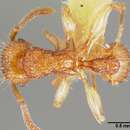en
names in breadcrumbs


Taxonomic history
Bolton, 1977 PDF: 99 (w.); Imai et al., 1985 PDF: 47 (k.).Combination in Tetramorium: Emery, 1901i PDF: 567; Donisthorpe, 1932c PDF: 468.Senior synonym of Tetramorium guineense macra: Bolton, 1977 PDF: 99.Senior synonym of Tetramorium melanogyna pallidiventre: Bolton, 1977 PDF: 99.Senior synonym of Tetramorium wilsoni: Bolton, 1977 PDF: 99.See also: Hita Garcia & Fisher, 2011 PDF: 22.I [introduced species]
(Figs 40, 45)
Myrmica insolens F. Smith , 1861: 47. Holotype female, Sulawesi: Menado (A. R. Wallace) (UM, Oxford) [examined]. Tetramorium insolens (F. Smith) ; Donisthorpe, 1932: 468. [For a full statement of current synonymy of insolens see Bolton, 1977: 99 with the exception of melanogyna Mann , for which see p. 173, this paper.]
Worker. TL 3.3 - 4.0, HL 0.78 - 0.94, HW 0.68 - 0.84, CI 84 - 88, SL 0.56 - 0.68, SI 78 - 86, PW 0.50 - 0.62, AL 0.92 - 1.08 (40 measured).
Mandibles smooth and shining, unsculptured except for scattered pits. Anterior clypeal margin with a median notch or impression; median portion of clypeus with three strong longitudinal carinae. Frontal carinae long and strong, extending back almost to occiput. Eyes of moderate size, maximum diameter c. 0.18 - 0.20, about 0.23 - 0.26 x HW. Pronotal corners in dorsal view angular. Propodeal spines long and stout, generally somewhat upcurved along their length, more rarely with the extreme apex of each spine suddenly upcurved. Metapleural lobes triangular, acute, somewhat upcurved. Petiole node in profile with anterior and posterior faces approximately parallel, the dorsum convex and rising slightly posteriorly so that the anterodorsal angle is on a slightly lower level than the posterodorsal, the latter angle usually sharper than the former, which has a tendency to be rounded. Dorsum of head to level of eyes with sparse longitudinal rugulae with a few cross-meshes and a fine but fairly conspicuous groundsculpture. Behind the level of the eyes the head is reticulate-rugose. Dorsal alitrunk with an irregular rugoreticulum which is usually strongest on the pronotum. Petiole and postpetiole reticulate-rugose both laterally and dorsally. Gaster unsculptured. All dorsal surfaces of head and body with abundant long erect or suberect hairs, those situated in a row on the upper surfaces of the frontal carinae between antennal insertion and occiput very long, distinctly longer than the maximum diameter of the eye. Colour varying from clear pale yellow to light orange-brown, usually with the gaster distinctly lighter in shade than the head and alitrunk. More rarely the ant is uniformly coloured.
The differences between this species and the closely related bicarinatum were tabulated in part 2 (Bolton, 1977) of this study. Basically, insolens differs from bicarinatum in having smooth mandibles, relatively long hairs on the frontal carinae (longer than maximum diameter of eye), gaster not darker in colour than alitrunk and the petiole a slightly different shape (compare Figs 43 and 45).
As a tramp-species insolens is by no means as successful as bicarinatum . It has a very wide range in the Pacific island-systems and is known from Indonesia, Philippines and the Solomon Islands. It was collected by E. O. Wilson in Sri Lanka, where it may be an introduction, and in England (in orchid house), Germany (zoological garden) and in the U. S. A. (near Los Angeles) where it is most certainly introduced. The Los Angeles specimens are deposited in USNM, Washington; for other localities see Bolton (1977).
Tetramorium insolens is a species of ant in the genus Tetramorium.[1] It is a medium-sized orange ant that is mainly seen on vegetation, has a monomorphic work caste with 12-segmented antennae, three-segmented antennal club, short antennal scapes that do not surpass the posterior margin of the head, a gradually sloped mesosoma, and strong propodeal spines. It has two waist segments and a gaster with a stinger.[2]
The species lives primarily and natively in the Pacific Island region,[3] with an invasive and non-native yet established presence recorded in Austria, Hungary, France, and the Netherlands.[4]
Tetramorium insolens is a species of ant in the genus Tetramorium. It is a medium-sized orange ant that is mainly seen on vegetation, has a monomorphic work caste with 12-segmented antennae, three-segmented antennal club, short antennal scapes that do not surpass the posterior margin of the head, a gradually sloped mesosoma, and strong propodeal spines. It has two waist segments and a gaster with a stinger.
The species lives primarily and natively in the Pacific Island region, with an invasive and non-native yet established presence recorded in Austria, Hungary, France, and the Netherlands.